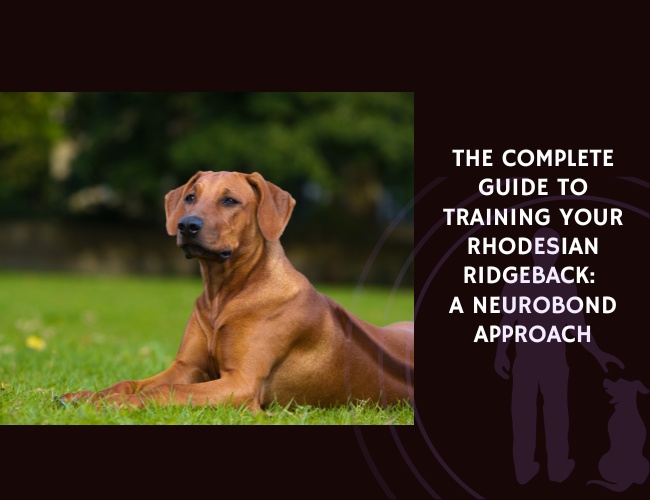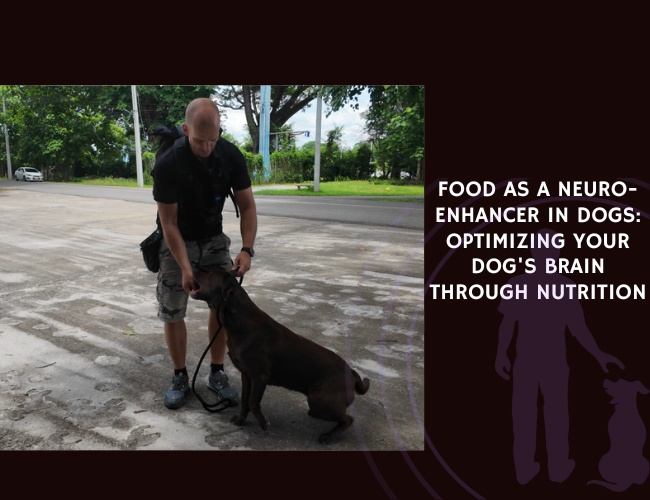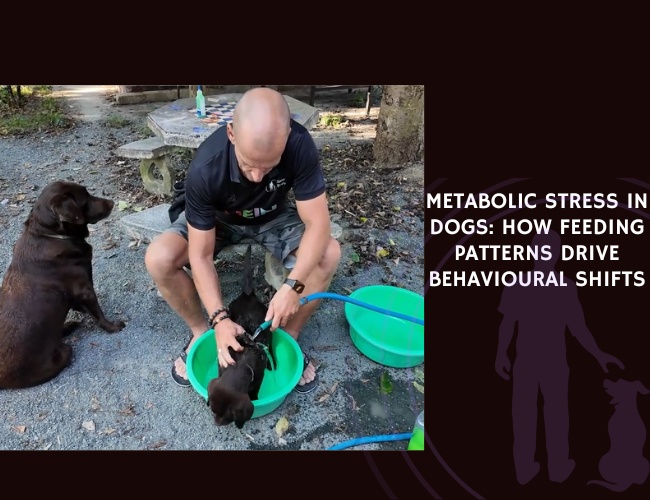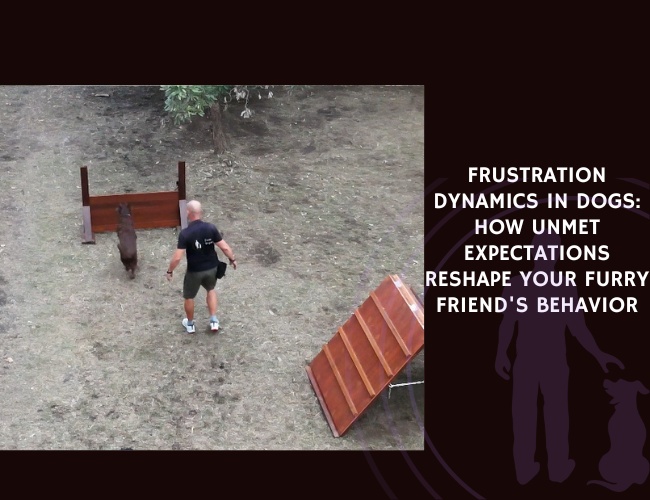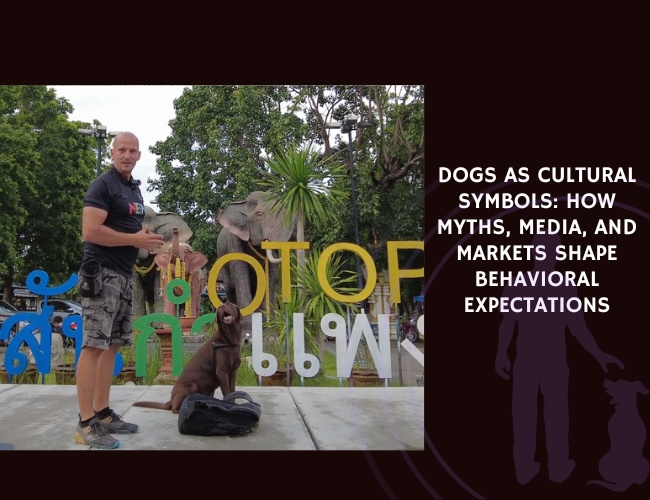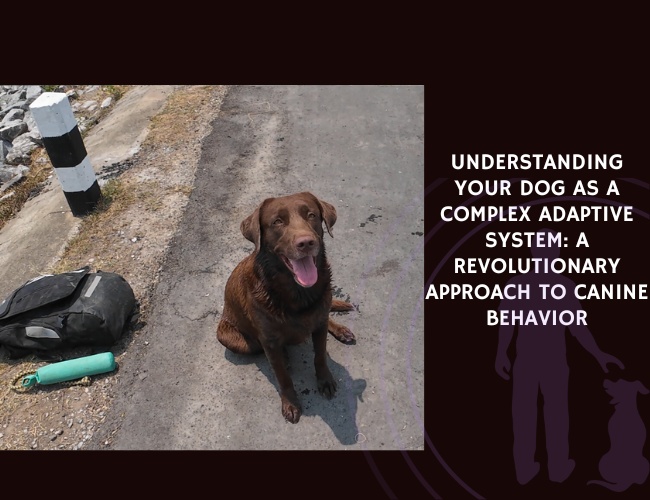Introduction
The Rhodesian Ridgeback stands as one of Africa’s most noble contributions to the canine world—a breed whose very essence embodies both fierce independence and profound loyalty. Originally bred to hunt lions in the African bush, these remarkable dogs carry within their DNA a complex tapestry of traits that make traditional training approaches often fall short. Their distinctive ridge of backward-growing hair serves as a visual reminder that this is no ordinary companion.
In this guide, we’ll explore how the NeuroBond approach—which honors the dog’s natural instincts while building deep connection—transforms the training journey with your Ridgeback from a battle of wills into a dance of mutual understanding. Let us guide you through a method that sees your dog not as a subject to control, but as an intelligent partner whose independence becomes an asset rather than an obstacle.
Character & Behavior
Understanding Your Ridgeback’s Core Nature
Your Rhodesian Ridgeback operates from a unique psychological blueprint that combines the confidence of a guardian with the sensitivity of a companion. This duality isn’t a contradiction—it’s the key to understanding their behavior. When we acknowledge that their independence stems from centuries of making split-second decisions in the African bush, we begin to see stubbornness not as defiance, but as thoughtful consideration.
The Independent Thinker Unlike breeds that look constantly to their handler for direction, your Ridgeback processes situations through their own cognitive framework first. This means when you call them during an interesting scent investigation, they’re not ignoring you—they’re weighing the value of compliance against their current activity. The NeuroBond approach leverages this by making connection more rewarding than independence, naturally shifting their decision-making in your favor.
Sensitivity Behind the Strength Beneath that muscular, imposing exterior lies a surprisingly sensitive soul. Ridgebacks possess what neuroscientists might call heightened amygdala responsiveness—they feel deeply and remember emotional experiences vividly. Harsh corrections don’t just fail with this breed; they damage the very foundation of trust that makes training possible. Your Ridgeback’s sensitivity is actually their superpower when channeled through positive experiences.
The Energy Equation High energy in Ridgebacks manifests differently than in typical working breeds. Rather than constant motion, they exhibit bursts of intense activity followed by periods of watchful rest. This energy pattern reflects their hunting heritage—conservation punctuated by explosive action. Understanding this rhythm helps you structure training sessions that align with their natural energy cycles rather than fighting against them.
Next, we’ll explore how your Ridgeback communicates their needs and emotions through a rich vocabulary of vocalizations and body language…
Vocalization & Communication
Decoding Your Ridgeback’s Language
Rhodesian Ridgebacks communicate through a sophisticated system that goes far beyond simple barking. Their vocalization patterns reveal layers of meaning that, once understood, become your roadmap to their inner world. In the NeuroBond framework, we don’t silence these communications—we learn to respond appropriately, creating a two-way dialogue.
The Ridgeback Vocabulary Your Ridgeback likely uses distinct vocalizations for different situations:
- Low, rumbling growls during play (contentment, not aggression)
- Sharp, single barks as alerts (their guardian instinct activating)
- Soft whines or “talking” sounds when seeking connection
- Deep, chest-resonating woofs when genuinely concerned
Each sound carries emotional weight and intention. By acknowledging these communications—even with just eye contact or a calm “I hear you”—you validate their expression while maintaining leadership.
Body Language as Primary Communication Watch your Ridgeback’s ridge—it tells stories. When those distinctive hairs stand more prominently, arousal levels are rising. This might indicate excitement, uncertainty, or heightened awareness. Combined with tail position (high and stiff versus relaxed wag), ear set, and overall body tension, you’re reading an emotional barometer.
Creating Dialogue, Not Monologue The NeuroBond approach transforms communication from commands into conversation. When your Ridgeback “talks back” during training, they’re not being defiant—they’re participating. This is where allowing the dog to be himself becomes powerful. Instead of suppressing their communication, we shape it into productive dialogue. A questioning whine becomes a check-in behavior. A play growl becomes an invitation for interaction.
In our next section, we’ll build on this communication foundation to create a training approach that honors your Ridgeback’s intelligence while establishing clear, respectful boundaries…
Training & Education
The NeuroBond Training Philosophy in Action
Training a Rhodesian Ridgeback requires abandoning the outdated notion of dominance and embracing a partnership model. Your Ridgeback’s ancestors didn’t survive African lions through blind obedience—they survived through intelligent cooperation with their human partners. This historical context shapes our modern approach.
Building the Invisible Leash The first step in Ridgeback training isn’t teaching “sit” or “stay”—it’s establishing the NeuroBond connection. This begins with simple presence exercises:
The Check-In Protocol: Start in a quiet space. Simply exist together without demands. When your Ridgeback naturally looks at you (and they will), mark this moment with calm praise or a gentle treat. You’re not commanding attention; you’re rewarding their choice to connect. Within days, you’ll notice increased eye contact—your Ridgeback is choosing you.
Standing on the Leash Technique: Place your foot gently on the leash, leaving enough slack for comfort but not enough for wandering. Don’t pull or correct. Your Ridgeback will naturally problem-solve, eventually choosing to sit or lie down. The moment they settle, release and reward. They’ve just learned that calm behavior creates freedom—a lesson they discovered themselves.
From Connection to Cooperation Once the bond is established, traditional “commands” become unnecessary. Your Ridgeback begins responding to subtle cues:
- A slight lean forward invites them to walk
- A pause in your movement suggests they should wait
- Your relaxed posture signals all is well
This isn’t magic—it’s relationship. Your Ridgeback, being the intelligent processor they are, reads these cues and chooses compliance because the relationship has value.
Addressing the Independence Factor When your Ridgeback “ignores” a recall, they’re not being stubborn—they’re being a Ridgeback. The NeuroBond solution? Make returning more valuable than independence. Start recall training in boring environments where you’re the most interesting option. Use their name like a celebration, not a command. When they choose to come, the reward isn’t just a treat—it’s play, adventure, or whatever your individual dog values most.
The Context Rule Remember: Ridgebacks are contextual learners. A “sit” in the kitchen doesn’t automatically transfer to “sit” at the park. This isn’t slow learning—it’s precise learning. Use this trait by practicing behaviors in multiple contexts, allowing your Ridgeback to generalize through experience rather than assumption.
Next, we’ll explore how to channel your Ridgeback’s natural athleticism and hunting heritage into fulfilling activities…
Performance & Activities
Channeling Ancient Instincts into Modern Purpose
Your Rhodesian Ridgeback carries within them the legacy of lions—not to fight, but to track, bay, and work in partnership with humans. This genetic programming doesn’t disappear in suburban backyards; it seeks expression. The NeuroBond approach doesn’t suppress these drives but provides constructive outlets that satisfy both instinct and modern life.
The Prey Drive Paradox That sudden bolt after a squirrel isn’t disobedience—it’s DNA activation. Traditional training might demand perfect recall even mid-chase, setting up inevitable failure. The NeuroBond method works differently:
Managed Hunt Games: Create controlled hunting experiences using scent work or tracking exercises. Hide treats or toys, then release your Ridgeback to “hunt.” You’re not fighting their instinct; you’re becoming the provider of hunting opportunities. This shifts their focus—why chase random squirrels when you provide better hunts?
The Switch Protocol: Teach your Ridgeback to toggle between “hunt mode” and “partner mode” using specific cues. A special harness or collar can signal work time. This contextual boundary allows full expression of their drives within agreed parameters.
Athletic Expression as Emotional Regulation Ridgebacks need more than physical exercise—they need purposeful activity. Their bursts of energy aren’t random; they’re expressions of internal states:
- Morning zoomies often indicate joy and anticipation
- Evening restlessness might signal unmet mental stimulation needs
- Destructive behavior typically reveals frustration, not defiance
Structure activities that address both body and mind:
- Endurance Building: Long, steady hikes satisfy their traveling heritage
- Sprint Sessions: Short, intense chase games honor their burst-hunting style
- Mental Challenges: Puzzle feeders and nose work engage their problem-solving nature
Performance as Partnership Whether in formal dog sports or backyard games, frame activities as collaborative ventures. Your Ridgeback excels when they feel like your partner, not your student. In agility, they’re navigating obstacles with you. In obedience trials, they’re demonstrating your teamwork. This subtle shift in perspective transforms performance from compliance to cooperation.
Let’s explore how proper nutrition supports both the physical demands and cognitive development of your remarkable Ridgeback…
Nutritional Recommendations
Feeding the Mind-Body Connection
Nutrition for a Rhodesian Ridgeback goes beyond filling a bowl—it’s about supporting their unique physiological and neurological needs. The NeuroBond approach recognizes that what goes into your dog directly impacts their ability to learn, connect, and thrive in partnership with you.
The Metabolic Reality Your Ridgeback’s metabolism reflects their dual nature: explosive power capability combined with efficient energy conservation. This means:
- They require high-quality protein to maintain their substantial muscle mass
- Their digestive systems often handle moderate, consistent meals better than large portions
- Energy needs fluctuate dramatically based on activity levels
Think of feeding as programming their operating system—quality input creates quality output in behavior, health, and training responsiveness.
Brain Food for the Thinking Dog Ridgebacks process situations cognitively before reacting, requiring optimal brain nutrition:
- Omega-3 fatty acids support neural pathway development and maintenance
- B-complex vitamins facilitate neurotransmitter production, affecting mood and trainability
- Antioxidants protect against cognitive decline, keeping senior Ridgebacks sharp
When your Ridgeback receives proper neural nutrition, you’ll notice improved focus during training, faster learning acquisition, and better emotional regulation—all crucial for NeuroBond development.
Feeding Rituals as Training Opportunities Transform mealtime into connection time:
The Patience Protocol: Your Ridgeback’s food bowl becomes a cooperation exercise. They wait calmly while you prepare, making eye contact before release to eat. This isn’t about dominance—it’s about creating mindful moments of connection multiple times daily.
Work-for-Food Enrichment: Use portion of meals for training rewards or puzzle feeders. Your Ridgeback’s problem-solving nature thrives when meals require thought. This mental stimulation often reduces behavioral issues more effectively than increased exercise.
Special Considerations for the Sensitive System Many Ridgebacks exhibit food sensitivities that manifest as:
- Skin irritations (check that ridge area especially)
- Digestive upset leading to irritability or reduced training focus
- Energy fluctuations affecting behavior consistency
Work with your veterinarian to identify optimal food choices. A comfortable dog is a trainable dog—digestive distress creates resistance to learning and connection.
Next, we’ll address the health factors unique to Ridgebacks and how they influence training success…
Fierce. Free. Focused.
Ridgebacks don’t obey—they evaluate.
Their loyalty isn’t given blindly—it’s earned through presence, not pressure. When they choose connection over instinct, it means you’ve become part of their inner world.
Their silence holds meaning, their stillness holds power.
They’re watchers before movers, thinkers before doers. Misread as stubborn, they’re simply discerning. Honor their rhythm, and they’ll move with you—willingly.

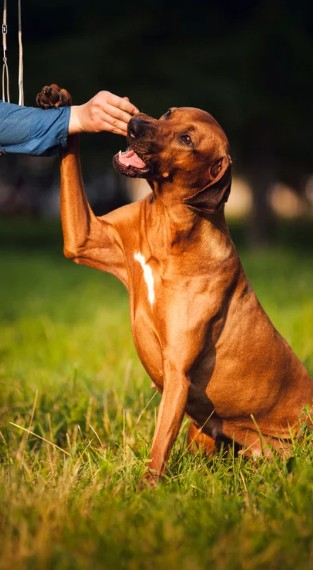
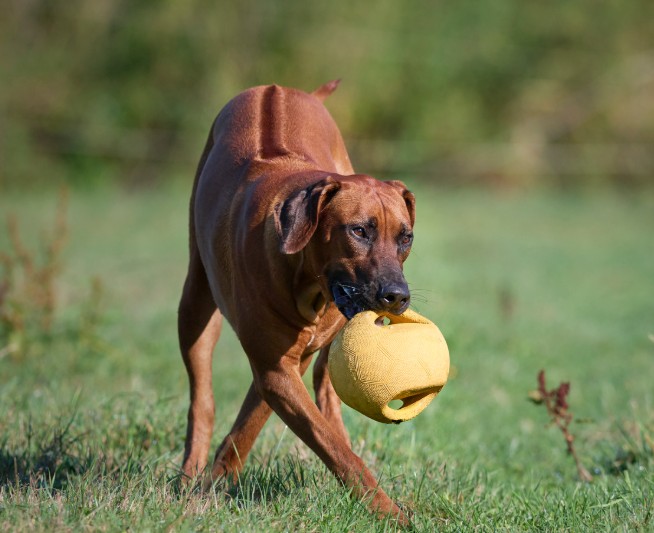
You don’t train a Ridgeback—you invite them to join you.
The invisible leash isn’t forged through control—it’s chosen in every quiet moment of mutual trust. And once chosen, they never look back.
Health Concerns
When Health Impacts Behavior and Training
Understanding your Rhodesian Ridgeback’s health predispositions isn’t just about medical management—it’s about recognizing how physical conditions influence behavior, training responsiveness, and the human-animal bond. The NeuroBond approach views health holistically, acknowledging that physical comfort enables emotional connection.
The Dermoid Sinus Factor This breed-specific condition, essentially a tube-like opening along the spine, can create subtle but significant behavioral impacts:
- Discomfort may manifest as touch sensitivity during training
- Affected dogs might resist certain positions or movements
- Pain can masquerade as stubbornness or training regression
Early detection and treatment remove this barrier to connection. A Ridgeback free from physical discomfort can fully engage in the trust-building exercises essential to NeuroBond development.
Hip Dysplasia and Training Adaptations Large, athletic breeds like Ridgebacks face joint challenges that require training modifications:
Surface Awareness: Train on varied, joint-friendly surfaces. Grass and dirt provide better cushioning than concrete for repetitive exercises.
Movement Patterns: Avoid repetitive jumping or sharp turns during young dog training. Instead, focus on controlled, fluid movements that build strength without stress.
The Comfort Check: Before labeling reluctance as disobedience, assess physical comfort. A Ridgeback who suddenly “forgets” how to sit might be experiencing joint discomfort, not defiance.
Sensitivity as a Health Indicator Your Ridgeback’s emotional sensitivity often provides early warning of health issues:
- Increased reactivity might signal underlying pain
- Sudden behavior changes warrant veterinary evaluation
- Appetite fluctuations affect training motivation and success
The NeuroBond connection you’ve built becomes your diagnostic tool—you’ll notice subtle changes before they become major issues.
Bloat Prevention Through Training Gastric dilatation-volvulus (bloat) poses serious risk to deep-chested Ridgebacks. Training protocols can reduce risk:
- Establish calm feeding routines (excitement increases air gulping)
- Train settle behaviors for post-meal rest periods
- Use puzzle feeders to slow consumption naturally
These aren’t just health precautions—they’re additional opportunities for mindful connection and impulse control development.
Now let’s explore how to create an environment that supports your Ridgeback’s unique needs…
Lifestyle & Environment
Creating a Ridgeback-Optimized Living Space
Your Rhodesian Ridgeback’s environment profoundly influences their behavior and training success. These dogs, bred for vast African territories, adapt remarkably to modern living—but only when their spatial and social needs are thoughtfully met. The NeuroBond approach sees environment as an active training partner, not just a backdrop.
Territory and Security Needs Ridgebacks maintain strong territorial awareness—a trait that served them guarding African homesteads. In your home, this translates to:
Defined Safe Zones: Create specific areas where your Ridgeback can retreat without disturbance. This might be a corner with their bed, a crate with the door removed, or a favorite sunny spot. Respect these zones absolutely—a dog who trusts their safe space trusts their human.
Perimeter Awareness: Your Ridgeback will naturally patrol property boundaries. Instead of discouraging this, incorporate it into your routine. Morning “boundary walks” satisfy this instinct while reinforcing your partnership in territory management.
Window Management: Strategic window access allows monitoring without overstimulation. Consider window films at dog height to reduce visual triggers while maintaining their watchdog satisfaction.
Social Architecture Ridgebacks thrive in structured social environments:
- They need clear understanding of household hierarchy (not dominance, but role clarity)
- Consistent routines reduce anxiety and improve training responsiveness
- Guest protocols should be established early—your Ridgeback decides friend from foe based on your cues
Environmental Enrichment for the Thinking Dog Static environments create behavioral problems. Your Ridgeback’s intelligence demands environmental complexity:
Rotation Principle: Regularly change toy availability, creating novelty without excess. A “new” toy every few days maintains engagement.
Scent Gardens: Designate outdoor areas for sensory exploration. Different herbs, safe plants, and texture varieties provide mental stimulation that burns energy without physical exhaustion.
Indoor Challenges: Weather-proof enrichment includes hiding treats in towels, creating obstacle courses from furniture, or setting up indoor tracking games.
The Integration Factor Your Ridgeback doesn’t just live in your environment—they need to feel integrated into your life rhythm:
- Include them in appropriate daily activities (they’re excellent home office companions)
- Create parallel activities—while you work, they work on a puzzle toy
- Establish predictable together-time and apart-time, reducing separation anxiety
As we consider the full life journey with your Ridgeback, let’s explore how the NeuroBond evolves through their senior years…
Senior Care
The Deepening Bond: NeuroBond in the Golden Years
The relationship with a senior Rhodesian Ridgeback represents the full flowering of the NeuroBond approach. Years of connection create an almost telepathic understanding, but aging brings new considerations that require adaptation, not abandonment, of your training philosophy.
Cognitive Changes and Compensation Senior Ridgebacks may experience cognitive shifts that affect training and behavior:
Processing Speed: Responses may slow, but this isn’t defiance—it’s processing time. Allow extra moments for your senior to register and respond to cues. Their eventual compliance often shows even deeper thought than their younger reactions.
Memory Flexibility: Well-established behaviors remain strong, but new learning requires patience. Use this by reinforcing foundation behaviors that boost confidence rather than introducing complex new tasks.
Sensory Adjustments: Diminished hearing or vision doesn’t diminish intelligence. Adapt your communication—hand signals replace verbal cues, vibration patterns on the floor signal approach, gentle touch maintains connection when other senses fade.
Physical Considerations in Continued Training The NeuroBond philosophy of “letting the dog be” becomes even more relevant:
- Replace high-impact activities with nose work and gentle problem-solving
- Swimming provides exercise without joint stress
- Short, frequent training sessions respect reduced stamina while maintaining mental engagement
The Wisdom of the Elder Ridgeback Senior Ridgebacks often display remarkable emotional intelligence:
- They become excellent teachers for younger dogs, modeling calm behavior
- Their reduced reactivity makes them ideal therapy or comfort companions
- The deepened bond allows for nuanced communication younger dogs can’t achieve
Quality of Life as Training Goal In senior years, training focuses on life quality enhancement:
Comfort Behaviors: Teach positions that ease arthritis (side-lying versus sphinx down) Medical Cooperation: Use positive reinforcement for medication routines or veterinary procedures Cognitive Maintenance: Simple training games keep minds sharp and spirits engaged
The investment in NeuroBond connection pays its greatest dividends now—your senior Ridgeback trusts you completely to guide them through aging challenges.
Conclusion: Is the Rhodesian Ridgeback Right for You?
The Truth About Life with a Ridgeback
After exploring the depths of Rhodesian Ridgeback behavior and training through the NeuroBond lens, one truth emerges clearly: this is not a breed for everyone—and that’s exactly as it should be. The Ridgeback requires not just an owner, but a partner willing to engage in a lifelong dance of mutual respect and understanding.
The Ridgeback Reality Check Ask yourself honestly:
- Can you embrace independence as intelligence rather than fighting it as defiance?
- Will you find joy in earning cooperation rather than demanding obedience?
- Do you have the patience to let your dog problem-solve rather than micromanaging behavior?
- Can you provide both physical outlets and mental challenges consistently?
- Will you respect their sensitivity while appreciating their strength?
If you answered yes, you’re ready for one of dogdom’s most rewarding partnerships.
The NeuroBond Promise When you commit to the NeuroBond approach with a Ridgeback, you’re not just training a dog—you’re entering into a relationship that will challenge and change you. Your Ridgeback will teach you:
- Patience isn’t passive—it’s actively choosing connection over control
- True leadership means being worthy of following, not demanding compliance
- The strongest bonds are built on mutual choice, not one-sided demands
- Intelligence in dogs, like humans, manifests in many forms
The Journey Ahead Your Ridgeback journey won’t be marked by perfect heel positions or robotically precise recalls. Instead, it will be measured in moments of chosen cooperation, in the soft eye contact that says “I’m with you,” in the voluntary closeness of a dog who could choose independence but chooses you instead.
This is the way of the Ridgeback—not easy, but infinitely rewarding. They offer not blind devotion but conscious partnership. In return, they ask for understanding, patience, and respect for the magnificent creature they are.
Welcome to the world of the Rhodesian Ridgeback, where every day brings new opportunities to deepen the bond that connects two different species in one remarkable partnership. The ridge on their back reminds us they’re unique—the bond in your heart proves they’re irreplaceable. 🧡

